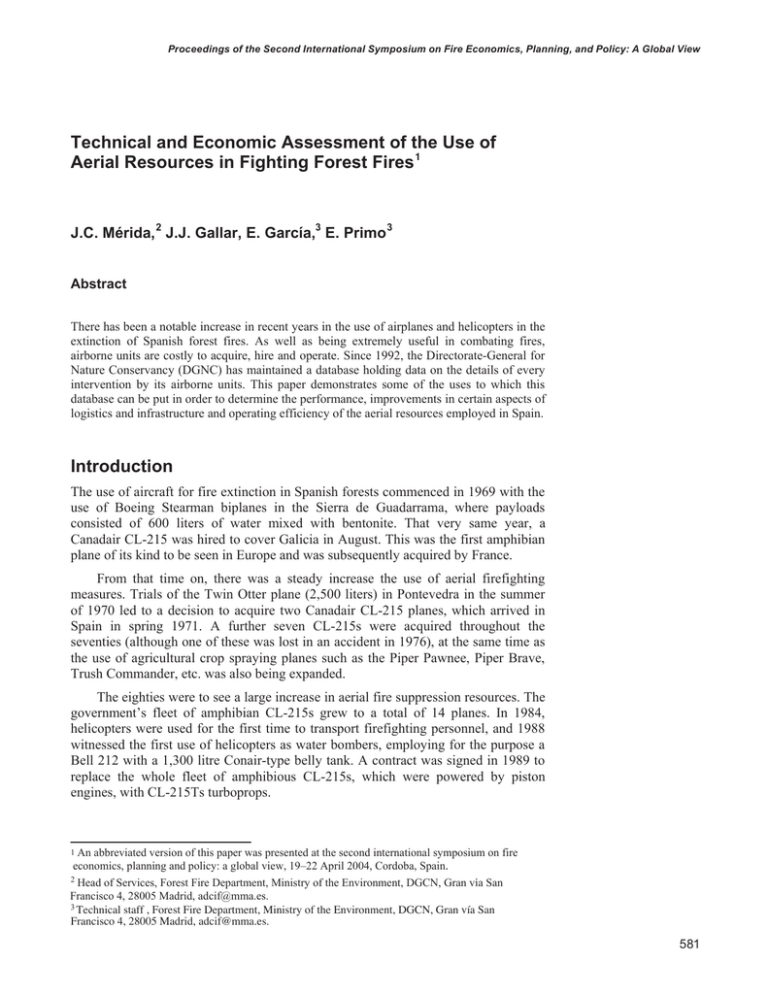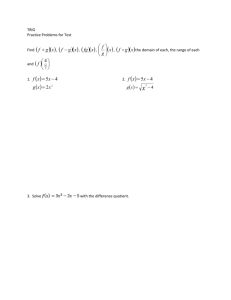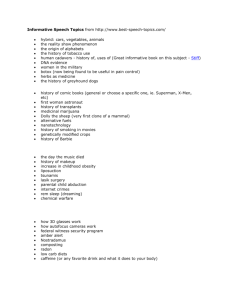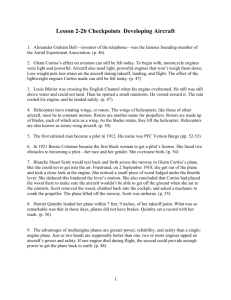Document 11233269
advertisement

Proceedings of the Second International Symposium on Fire Economics, Planning, and Policy: A Global View Technical and Economic Assessment of the Use of Aerial Resources in Fighting Forest Fires 1 J.C. Mérida, 2 J.J. Gallar, E. García,3 E. Primo 3 Abstract There has been a notable increase in recent years in the use of airplanes and helicopters in the extinction of Spanish forest fires. As well as being extremely useful in combating fires, airborne units are costly to acquire, hire and operate. Since 1992, the Directorate-General for Nature Conservancy (DGNC) has maintained a database holding data on the details of every intervention by its airborne units. This paper demonstrates some of the uses to which this database can be put in order to determine the performance, improvements in certain aspects of logistics and infrastructure and operating efficiency of the aerial resources employed in Spain. Introduction The use of aircraft for fire extinction in Spanish forests commenced in 1969 with the use of Boeing Stearman biplanes in the Sierra de Guadarrama, where payloads consisted of 600 liters of water mixed with bentonite. That very same year, a Canadair CL-215 was hired to cover Galicia in August. This was the first amphibian plane of its kind to be seen in Europe and was subsequently acquired by France. From that time on, there was a steady increase the use of aerial firefighting measures. Trials of the Twin Otter plane (2,500 liters) in Pontevedra in the summer of 1970 led to a decision to acquire two Canadair CL-215 planes, which arrived in Spain in spring 1971. A further seven CL-215s were acquired throughout the seventies (although one of these was lost in an accident in 1976), at the same time as the use of agricultural crop spraying planes such as the Piper Pawnee, Piper Brave, Trush Commander, etc. was also being expanded. The eighties were to see a large increase in aerial fire suppression resources. The government’s fleet of amphibian CL-215s grew to a total of 14 planes. In 1984, helicopters were used for the first time to transport firefighting personnel, and 1988 witnessed the first use of helicopters as water bombers, employing for the purpose a Bell 212 with a 1,300 litre Conair-type belly tank. A contract was signed in 1989 to replace the whole fleet of amphibious CL-215s, which were powered by piston engines, with CL-215Ts turboprops. An abbreviated version of this paper was presented at the second international symposium on fire economics, planning and policy: a global view, 19–22 April 2004, Cordoba, Spain. 2 Head of Services, Forest Fire Department, Ministry of the Environment, DGCN, Gran vía San Francisco 4, 28005 Madrid, adcif@mma.es. 3 Technical staff , Forest Fire Department, Ministry of the Environment, DGCN, Gran vía San Francisco 4, 28005 Madrid, adcif@mma.es. 1 581 GENERAL TECHNICAL REPORT PSW-GTR-208 Session 2C—Technical and Economic Assessment—Mérida, Gallar, Primo In the nineties, aerial fire extinction units were increasingly being acquired by regional governments (Comunidades Autónomas) when they became responsible for firefighting activities between 1983 and 1985, which led to the national government making efforts to differentiate it by developing a focus on large capacity airplanes capable of being deployed over the whole of the country. There was frequent use of eastern European aircraft such as the Mi-8, Mi-2, Sokol PZL and KAMOV helicopters. In 1992, the Special Forest Fire Reinforcement Brigades (BRIF) were created, with transport capacity provided by Russian Army Mi-8 helicopters. Towards the end of the nineties there were 20 amphibian planes in service (15 CL215T and 5 CL-215). At the same time, planes such as the CANSO PBY, Thrush Commander and Grumman were gradually discarded. In 2003, 206 airplanes (Table 1) were employed during the summer campaign, 48 of which were owned by the national government, operating out of 157 bases. The entire fleet offers a tanker capacity of 396,000 liters (236,000 liters of which is provided by the Comunidades Autónomas and 160,000 liters by the DGNC), a seating capacity of 845 (704 corresponding to the Comunidades Autónomas and 141 to the DGNC). The fleet cost approximately 65.5 million euros to hire and operate (39.7 million euros for the Comunidades Autónomas and 25.8 million euros for the DGNC). The tendency in Spain is currently to place more emphasis on improving the capabilities of the aircraft rather than on increasing the actual number of aircraft available or more hired capacity. The amount of money involved means that the use of airborne firefighting equipment cannot escape serious economic analysis of the performance and efficiency of this particular technique. Table 1--Aircraft Use in Spain in 2003. Region Andalusia Aragon Asturias Balearics Canaries Cantabria Castilla La Mancha Castilla León Catalonia Extremadura Galicia La Rioja Madrid Murcia Navarre Basque Country C. Valenciana DGNC TOTAL 582 CL-215 CL-215T 0 0 0 0 0 0 0 0 0 0 0 0 0 0 0 0 0 14 14 Airplanes ACT C-130 3100 l. 5 0 0 0 0 0 2 0 0 0 0 0 0 0 3 0 3 0 0 0 1 0 0 0 0 0 0 0 0 0 0 0 3 0 10 1 1 27 ACT 2100 l. 0 0 0 1 0 0 8 0 0 0 7 2 0 0 0 0 4 3 25 HB 4500 l. 2 0 0 0 0 0 0 0 0 0 0 0 0 0 0 0 0 4 6 HT 2500 l. 0 0 0 0 0 0 0 0 0 0 0 0 0 0 0 0 0 3 3 Helicopters HT H 1500 l. 1200 l. 16 0 0 0 1 0 0 1 0 2 0 1 0 6 0 20 0 11 0 2 12 0 0 0 0 6 0 1 0 2 0 0 0 7 10 0 23 75 H 500 l. 0 4 3 2 0 0 0 0 5 4 0 0 0 1 0 0 0 0 19 Leadplanes 2 0 0 1 0 0 0 0 1 0 2 0 1 1 0 0 1 4 13 Proceedings of the Second International Symposium on Fire Economics, Planning, and Policy: A Global View Session 2C—Technical and Economic Assessment—Mérida, Gallar, Primo The DGNC’s aerial resources database The Directorate-General for Nature Conservancy, under the aegis of the Ministry of the Environment, has gathered data on a standard form since 1992, recording the operations undertaken by the aircraft under its control. The form is used whenever an aircraft has taken off, whether to extinguish a fire, on a false alarm, on a reconnaissance mission or any other reason. The form is set out on a spread sheet and is therefore easy to record and manipulate on computers. A program called RMAIF was written for this specific purpose and employs Visual Basic as the programming language and ACCESS as the database program used to process the data on the forms and obtain specific manipulated data. If one includes the full input of data for 2003, the database has a total of 19,860 entries. This program has made it possible in recent years to develop performance graphs for each of the distinct types of aircraft, to improve the logistics of aerial operations, simulate alternative patterns of distribution and use, undertake an economic evaluation of the cost per litre of water dropped on fires, choose higher performance models and analyze the working practices of the air bases and contractors. All of these data have been employed to shape the way the aerial firefighting equipment controlled by the Spanish Ministry of the Environment is distributed and operated. Some of the many uses of the database are discussed below: Performance indicators for specific aircraft types The available information in the database has made it possible to produce graphs illustrating the performance of different aircraft types based on the distance between the fire and the point where the water is loaded. The most satisfactory results have been achieved with semi-logarithmic plotting, where y = k – a ln x. This has achieved correlation coefficients of over a r2 = 0,60, where y = the number of discharges per hour, k and a are constants depending on the type of aircraft and x = the distance between the fire and the point where the water is loaded (Graph 1). 583 USDA Forest Service Gen. Tech. Rep. PSW-GTR-xxx. xxxx. GENERAL TECHNICAL REPORT PSW-GTR-208 Session 2C—Technical and Economic Assessment—Mérida, Gallar, Primo 9,00 = 7,49-1,44·Ln(x) y =Y -1,4416Ln(x) + 7,4889 2R2=0,61 R = 0,5961 DESCARGAS/HORA 8,00 7,00 6,00 5,00 4,00 3,00 2,00 1,00 0,00 0 5 10 15 20 25 30 35 40 45 50 55 60 65 70 75 80 85 90 95 100 105 DISTANCIA A PUNTO DE CARGA (km) Graph 1ʊ“Performance of Airtractor 802”. With input data based on 5 km class intervals and an average performance within each interval, the same curve produces correlations of over 90 percent (Graph 2). 7,00 Y = 6,19 -1,81·Ln(x) y = -1,811Ln(x) + 6,1919 2 2R =0,96 R = 0,9638 DESCARGAS/HORA 6,00 5,00 4,00 3,00 2,00 1,00 0,00 0 5 10 15 20 25 30 35 40 45 50 55 60 65 70 75 DISTANCIA A PUNTO DE CARGA (km) Graph 2ʊ“Performance of Airtractor 802” 584 USDA Forest Service Gen. Tech. Rep. PSW-GTR-xxx. xxxx. Proceedings of the Second International Symposium on Fire Economics, Planning, and Policy: A Global View Session 2C—Technical and Economic Assessment—Mérida, Gallar, Primo The semi-logarithmic curves are asymptotic to the x-axis, which means that an increase in distance leads to a decline in the performance of the aircraft, tending to zero over very long distances. Given that the graphs are difficult for field workers to manage in view of the logarithms, they have been simplified by converting them into straight lines which solely cover the intervals between nought and 50 km in respect of the planes and 0-25 km for the helicopter bombers (Graph 3). It is not considered appropriate to employ aircraft over greater distances due to the heavy cost with respect to the volumes of liquid they are capable of discharging. The fire fighting teams are therefore provided with simplified calculations of the following type: y = a – b x, which is easy to memorize and use, and which offer information on the foreseeable performance of the aircraft in question in extinguishing the fire. 8,00 Y = 6,06 -0,088·x 2 R =0,83 DESCARGAS/HORA 7,00 6,00 5,00 4,00 3,00 2,00 1,00 0,00 0 5 10 15 20 25 30 35 40 45 50 DISTANCIA A PUNTO DE CARGA (km) Graph 3ʊ “Performance of Canadair Cl215” Calculations such as discharges per hour = 6 minus 0.88 discharges per hour for every additional 10 km between the loading point and the fire for a CL-215 airplane (y = 6 – 0.88 x), are common currency amongst Extinction Team Leaders. Improvements in logistics and infrastructure for aerial operations An analysis of the database makes it possible to obtain information on the characteristics of the work carried out by each individual aircraft and its effectiveness, which facilitates the detection of problems and highlights areas which are capable of improvement. Two examples are given below. 1) A comparison between the operations and output of two Sokol PZL helicopters with a firefighting team and 1,500 liters bambi bucket (Table 2). 585 USDA Forest Service Gen. Tech. Rep. PSW-GTR-xxx. xxxx. GENERAL TECHNICAL REPORT PSW-GTR-208 Session 2C—Technical and Economic Assessment—Mérida, Gallar, Primo Following the usual analysis in 2002 of all the data on aircraft performance obtained in the summer from every air base in the country, there was a noticeable difference in performance between two Sokol PZL helicopters, one of which was stationed at Becerreá, in the province of Lugo, and the other stationed at Tineo, in the province of Asturias. The two helicopters had a very similar number of flight hours on extinction duties and both were operated by the same company. The air bases were less that 60 km. apart and were located in the same mountain range, which meant that the terrain where they were working was very similar. As a result, there should not have been any significant differences between the performances of the two helicopters. Table 2—Comparison between the operations and output of two Sokol PZL helicopter with a firefighting team and 1,500 liters bambi bucket. PARAMETER Number of firefighting sorties Number of fires attended Flying hours on fire duty People transported Bucket discharges People per hour Discharges per hour Becerreá 2000 101 95 214:37 970 1,331 4.52 6.20 2001 44 39 86:35 461 567 5.32 6.55 Tineo 2002 2000 78 77 125:27 710 904 5.66 7.21 77 63 217:28 815 931 3.75 4.28 2001 52 49 92:38 510 439 5.51 4.74 2002 25 19 55:10 246 436 4.46 7.90 An analysis of the data revealed that the only significant difference which might explain the discrepancy was the “distance between the loading point and the fire”, which was much greater in the case of Tineo. Fire extinction managers in Asturias were subsequently contacted and a water point construction programme was then carried out in 2001 and 2002, which enabled the performance of the Sokol PZL at Tineo to rise from 4.28 discharges per hour in 2000 to 4.74 and 7.90 discharges per hour in the next two years respectively. 2) Improvement of the helicopter fuel supply logistics . Forest fire fighting professionals are almost unanimous in their opinion that helicopters are “the machine which runs out of fuel just when it’s most needed”. It is indeed true that heavy helicopters bring high water-carrying capacity but also high fuel consumption and a shorter range than airplanes. On frequent occasions, helicopters are sent on firefighting duties a very long way from their normal air base. It is necessary to ensure that plans take into account the fuel needed to supply the helicopters at locations close to the fire, as the aircraft will otherwise need to make long trips with no payload, which reduces the actual time spent at the site of the fire. One approach is to send a mobile fuel tank with the helicopter to be placed near the site of the fire. The table (Table 3) below presents the operations data obtained from the first KAMOV helicopter fitted in 1994 with a 4,500 litre bambi bucket to be used in Spain. It was not accompanied by a mobile fuel tank. A simulation was set up to determine what would have happened if such a fuel tank had been available, had been 586 Proceedings of the Second International Symposium on Fire Economics, Planning, and Policy: A Global View Session 2C—Technical and Economic Assessment—Mérida, Gallar, Primo placed 10 km away from the fire and had been used from the 3rd refueling onwards in long-lasting forest fires over 75 km away from the main air base. PARAMETER Table 3—Operations data from the first KAMOV helicopter fitted with a 4,500 liters bambi bucket in 1994 used in Spain. No. of fires Flying time (min) Refueling time (min) Refueling time as % No. of discharges Discharges per hour Cost of contractor (million pesetas) Cost per litre (peseta/l) ACTUAL DATA Situation Situation Situation A B C 26 19 7 6,300 4,195 2,105 2,405 1,935 470 38.20 46.10 22.30 440 245 195 4.19 3.50 5.56 49.50 28.10 SIMULATION Situation D 26 6,300 690 11.00 827 7.88 53.00 16.00 Situation A: All flights to fires are taken into account Situation B: Only includes those flights with refueling from the main base Situation C: Only includes those flights with refueling at another base Situation D: Simulation taking into account all flights and including refueling with a mobile fuel tank at 10 km. from the site of the fire, a distance to the main base to refuel of over 75 km. and from the 3rd refueling onwards. The percentage of flying time spent refueling is reduced by 38.20 to 11%. The aircraft’s performance increases from 4.19 to 7.88 discharges per flying hour. The following example (Table 4) sets out the data obtained from the operations carried out by two different helicopters, a KAMOV K32A and a SOKOL PZL, hired by the DGNC during the Buendía forest fire in the province of Cuenca in 2003. In this particular forest fire, the pump on the mobile fuel tank happened to be nonoperational and was impossible to replace. As a result, the helicopters were obliged to refuel at bases which were quite a long way from the fire itself (Buenache and Villares). A comparison was made between the real firefighting activity of the helicopters and data simulating the existence of fuel tanks during the second and third days of the fire. The difference generated by the absence of a fuel tank close to the fire was equivalent to 32 discharges from an amphibious CL-215T (168,000 liters). 587 USDA Forest Service Gen. Tech. Rep. PSW-GTR-xxx. xxxx. GENERAL TECHNICAL REPORT PSW-GTR-208 Session 2C—Technical and Economic Assessment—Mérida, Gallar, Primo Table 4—Comparison of two DGNC helicopters performance in the Buendía forest fire Days firefighting Flying hours Time firefighting Time refueling Refueling time as % Distance to Buenache Distance to Villares Distance to fuel tank Discharges Water volume Perf.. Discharges/hour Perf. Liters/hour Cost in euros/litre Actual data 1 7:15 4:15 3:00 41.38 75 75 300,00 0 10.34 41,380 0.078 KAMOV Simulated data 1 7:15 6:07 1:08 15.63 75 5 108 432,000 15.00 60,000 0.054 Actual data 4 22:42 12:42 10:00 44.05 81 96 120,000 4.23 5,286 0.447 SOKOL Simulated data 4 22:42 16:30 6:12 27.31 81 5 125 156,250 5.51 6,883 0.343 Cost per litre of water deposited on the forest fire (BCL) The DGNC employs the basic cost of each litre of water (BCL) deposited on the fire as an indicator which combines both aircraft performance and financial cost. In order to enable comparisons between different aircraft, the cost calculation solely takes into account the flying time actually spent extinguishing fires, and excludes false alarms and returns to base before entering into action because the fire is already under control, etc. The unitary value of flying hours is determined as a quotient between the cost of contracting the aircraft and the number of hours for which it has been contracted. The volume of water is calculated as the result of the average discharge volume (assuming that these are discharges solely of water) divided by the number of discharges. The indicator thus obtained is independent of the number of flying hours for each aircraft and the use of retardants. In addition to the indicator, the data also provides a measure of the real cost per litre discharged which includes manpower costs, infrastructure costs for the air base, the cost of retardants deployed on the fire, real flying time, etc. However, the variable nature of this data means that the figure for real cost cannot be used as an indicator enabling comparisons between different types of aircraft and bases. The results in 2003 (Table 5)for aircraft either owned or hired by the DGNC were as follows: 588 Proceedings of the Second International Symposium on Fire Economics, Planning, and Policy: A Global View Session 2C—Technical and Economic Assessment—Mérida, Gallar, Primo Table 5—Cost per liter of water dropped in 2003 for aircrafts owned or rented by DGNC. BCL (€/litre). 2003 Aircraft Amphibious CL-215T planes Amphibious CL-215 planes Hercules C-130 plane AT-802 planes Dromader PZL planes KAMOV K-32A helicopters Minimum €/l. Base 0.132 Pollensa 0.335 Talavera 0.172 Son Bonet 0.112 Rosinos 0.094 Caravaca Average 0.224 0.353 2.168 0.244 0.134 0.114 €/l. 0.398 0.559 0.275 0.141 0.201 Maximum Base Torrejón (pre-season) Matacán (pre-season) Manises Tafalla Los Rodeos Although this indicator is not the only tool relied on to determine the use of a particular aircraft model in the fleet, it has provided the basis for many decisions to dispense with the services of aircraft with a lower efficiency figure. As a result, the CANSO PBY planes were no longer hired after 1995 due to a BCL of 85.8 pesetas/litre compared to a BCL of 22.3 pesetas/litre for the CL-215T, and a BCL of 26.7 pesetas/litre for the Dromader PZL planes in 1994. Furthermore, in 1995, use was made for the first time in Spain of the Mi-17 helicopter for water bombing. In view of its BCL of 42.5 pesetas/litre, against a CBLaverage of 15.62 pesetas/litre for the KAMOV helicopters, the Mi-17 was not hired again. 589 Page left blank intentionally.





